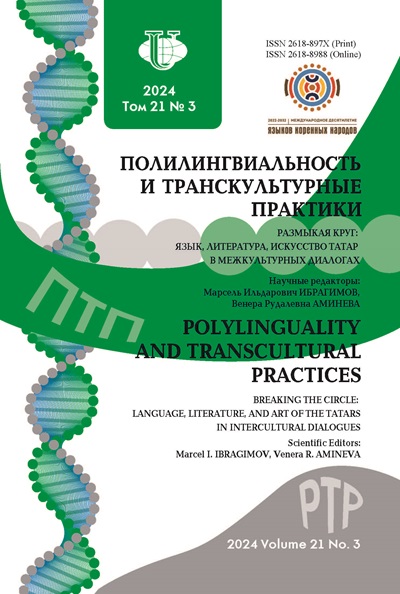Features of Functioning of the Erzya-Russian Bilingualism in the Aspect of Code switching
- Authors: Mosina N.M.1
-
Affiliations:
- National Research Ogarev Mordovia State University
- Issue: Vol 20, No 3 (2023)
- Pages: 472-483
- Section: Language Processes
- URL: https://journals.rudn.ru/polylinguality/article/view/36362
- DOI: https://doi.org/10.22363/2618-897X-2023-20-3-472-483
- EDN: https://elibrary.ru/WKSFVG
Cite item
Full Text
Abstract
This article is devoted to the study of Erzya-Russian bilingualism in the aspect of code switching on the territory of the Republic of Mordovia. The aim of the study is to present the types of intra-phrase code switching based on the material of narrative recordings of Erzya-Russian bilingual children. Special attention is paid to the study of the peculiarities of the functioning of native and non-native languages in a bilingual society, the mechanisms of code switching in children, taking into account the (non-) correspondence of structures in two languages and different strategies of native speakers’ response when using two languages in one unit of discourse. The source base of this study was the materials of the spontaneous narrative collected by the author of the article in 2017-2019. The informants are bilingual children aged 4 to 7 years inclusive. The research methods were the descriptive method of factual material, narrative sampling, included and not included observation.
Keywords
About the authors
Natalya M. Mosina
National Research Ogarev Mordovia State University
Author for correspondence.
Email: natamish@rambler.ru
ORCID iD: 0000-0003-1742-5438
PhD in Philology, Professor at the Department of English Language for Professional Communication
68, Bolshevistskaya Str., Saransk 430005, Republic of Mordovia, Russian FederationReferences
- Mosin, M.V., L.P. Vodjasova, Mosina, N.M., and N.V. Chinaeva. 2017. Didactic potential of bilingualism in teaching a foreign language. Integration of Education 21 (4): 751–764. https://doi.org/10.15507/1991-9468.089.021.201704.751-764. Print. (In Russ.).
- Dzhioeva, G.H. 2021. Development of functional bilingualism in primary school students by means of national games. CITIS 4 (30): 26–33. https://doi.org/10.15350/2409-7616.2021.4.03. Print. (In Russ.).
- Mosina, N.M., N.V. Kazaeva, and Batina, S.V. 2020.Features of mastering a foreign (Finnish, Hungarian) language by bilinguals). Finno-Ugric World 12 (3): 250–258. https://doi.org/10.15507/2076-2577.012.2020.03.250-258. Print. (In Russ.).
- Shherba, L.V. 1974. On the issue of bilingualism. Language system and speech activity. Leningrad. Print. (In Russ.).
- Rozencvejg, V.Ju. 1972. Basic questions of the theory of language contacts. In New in Linguistics. Language contacts VI. Moscow. Print. (In Russ.).
- Mihal’chenko V.Ju. 2006. Dictionary of sociolinguistic terms. Moscow: Rossijskaja akademija nauk. Institut jazykoznanija publ. Print. (In Russ.).
- Chirsheva, G.N., and P.V. Korovushkin. 2021. Code switching in the speech of five-year-old bilingual children. Vestnik Tomskogo gosudarstvennogo universiteta. Filologija 71: 169–184. https://doi.org/10.17223/19986645/71/10. Print. (In Russ.).
- Tabachnikov, Ju.Ju., and R.G. Gataullin. 2021. Switching from one language to another: code-switching. Doklady Bashkirskogo universiteta 6 (3): 215–218. https://doi.org/10.33184/ dokbsu-2021.3.13. Print. (In Russ.).
- Rubakova, I.I., and A.O. Vas’ko. 2022. Language attrition in the oral speech of bilinguals and ways to overcome it (linguo simulator project)). Vestnik Chuvashskogo gosudarstvennogo pedagogicheskogo universiteta im. I.Ja. Jakovleva 2 (115): 104–114. https://doi.org/10.37972/chgpu.2022.115.2.015. Print. (In Russ.).
- Isurin, L., W. Donald., and Kees, de B. (eds.) 2009. Multidisciplinary approaches to codeswitching. Amsterdam: John Benjamins. Print.
- Stell, G., and Y. Kofi. 2015. (eds.) Code-switching between structural and sociolinguistic perspectives. Vol. 43. Berlin: Mouton de Gruyter. Print.
- Milroy, L., and P. Muysken (eds.) 1995. One speaker, two languages: Cross-disciplinary perspectives on code-switching. New York: Cambridge University Press. Print.
- Gumperz, J.J. (ed.) 1982. Discourse strategies. Cambridge: Cambridge University Press. Print.
- Grosjean, F. 1982. Life with two languages. An introduction to bilingualism. Cambridge Mass.: Harvard University Press. Print.
- Gardner-Chloros, P. (ed.) 2009. Code-switching. Cambridge: Cambridge University Press. Print.
- Muysken, P. 2000. Bilingual speech: A typology of code-mixing. Cambridge: Cambridge University Press. Print.
- Mayer, M. 1980. Frog, where are you? A Puffin Pied Piper: New York. Print.
- Deuchar, M. 2005. Congruence and Welsh–English code-switching. Bilingualism: Language and Cognition 8 (3): 255–269.
- Mahootian, S. 2006. Code switching and mixing. In Encyclopedia of language and linguistics. 2nd edition. Amsterdam: Elsevier. Pp. 511–527. Print.
- Shagal, K. 2016.Contact-induced grammatical phenomena in the Russian of Erzya speakers. In Mordvin languages in the field. Uralica Helsingiensia. Vol. 10. Helsinki. 363–377. Print.
- Corbett, G.G. (ed.) Gender. 1991. Cambridge: Cambridge University Press, V. 6.
- Kovács, M. 2001. Code-switching and Language Shift in Australian Finnish in Comparison with Australian Hungarian. Åbo: Åbo AkademiUniversity Press.















